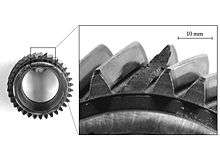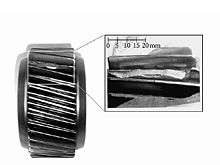Tooth interior fatigue fracture


Tooth interior fatigue fracture, (TIFF), is a type of gear failure. The failure is characterised by a fracture at approximately mid-height on the tooth of the gear. This distinguishes it from a tooth root fatigue failure. The crack for a TIFF is initiated in the interior of the tooth. This distinguishes TIFF from other fatigue failures of gears. TIFF has been observed in case-hardened idlers (i.e. gear wheels loaded on both flanks during each revolution).
The TIFF fracture surface has a distinct plateau in the central part along the tooth width and approximately mid-height of the tooth. In a close-up of the cross-section of the TIFF small wing cracks are observed. The presence of the wing crack indicates that the main crack has propagated from the centre of the tooth toward the tooth flank.
The crack-producing stresses of TIFF are twofold: i) constant residual tensile stresses in the interior of the tooth due to case hardening; and ii) alternating stresses due to the idler usage of the gear wheel.
Contact fatigue begins with surface distress, which can grow to spalling. In severe cases a secondary crack can grow from a spalling crater through the tooth thickness and a part of the tooth can fall off. In contrast to the fracture of severe contact fatigue, spalling craters are not necessary at the flank surface for a TIFF.
See also
References
- MackAldener, Magnus; Mårten Olsson (2000). "Interior Fatigue Fracture of Gear Teeth". Fatigue and Fracture of Engineering Materials and Structures. 23 (18): 283–292.
- MackAldener, Magnus; Mårten Olsson (December 2002). "Analysis of crack propagation during tooth interior fatigue fracture". Engineering Fracture Mechanics. Elsevier Science Ltd. 69 (18): 2147–2162. doi:10.1016/S0013-7944(02)00016-4.